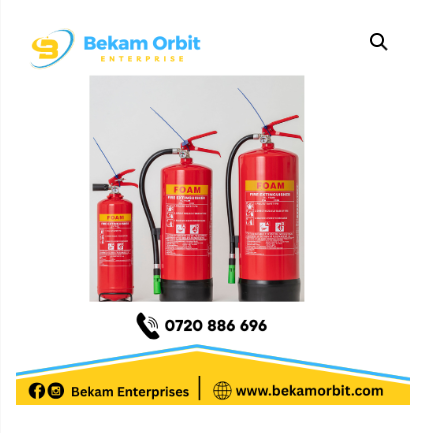Fire emergencies are unpredictable and often escalate in a matter of seconds. One of the most effective tools for rapid response is a fire extinguisher, but knowing how to use it correctly can be the difference between control and catastrophe. Among the most versatile types available today is the CO₂ foam fire extinguisher, a hybrid solution that combines the benefits of both carbon dioxide (CO₂) and foam to suppress a variety of fires quickly and safely.
This article will walk you through how to use a CO₂ foam fire extinguisher properly during an emergency, understand its unique strengths, and avoid common mistakes.
What Is a CO₂ Foam Fire Extinguisher?
A CO₂ foam extinguisher is a dual-action fire suppressant that uses carbon dioxide gas and foam solution to combat fires. The CO₂ quickly displaces oxygen, effectively suffocating the flames, while the foam forms a barrier that cools and prevents reignition. This makes it suitable for Class B fires (flammable liquids) and electrical fires, and in some cases, limited use on Class A fires (ordinary combustibles).
When to Use a CO₂ Foam Fire Extinguisher
Before reaching for a CO₂ foam fire extinguisher, it’s important to know which types of fires it is designed to handle:
- Class B Fires: Fires involving petrol, diesel, paint, and solvents.
- Electrical Fires: Fires caused by energized equipment such as computers, servers, or circuit panels.
- Limited Class A Use: Some foam compounds can suppress ordinary combustibles, but not as effectively as water-based extinguishers.
Do NOT use on cooking oil fires (Class F) or metal fires (Class D).
Steps to Properly Use a CO₂ Foam Fire Extinguisher
In an emergency, follow these essential steps to use a CO₂ foam fire extinguisher effectively:
1. Assess the Situation
Before approaching the fire, ensure your escape route is clear. If the fire is too large or spreading rapidly, evacuate immediately and call emergency services.
2. Pull the Pin
Break the tamper seal and pull out the safety pin located near the top of the extinguisher handle. This action will allow you to discharge the extinguisher.
3. Aim at the Base of the Fire
Point the nozzle at the base of the flames. Never aim at the top of the fire, as this will not extinguish the fuel source.
4. Squeeze the Handle
Firmly squeeze the handles together to release both CO₂ gas and foam. The extinguisher may emit a loud noise and cold gas—this is normal.
5. Sweep Side to Side
Using a controlled, sweeping motion, move the nozzle side to side, still aiming at the base of the fire. Maintain a safe distance—typically 1.5 to 2 meters—and move closer only if the fire diminishes.
6. Watch for Reignition
Even if the flames appear, continue applying foam for a few more seconds. Foam helps prevent the fire from reigniting by forming a cooling seal over the surface.
Safety Precautions When Using CO₂ Foam Extinguishers
Proper use isn’t just about technique—it’s also about awareness. Here are key safety precautions:
- Ventilation is crucial: CO₂ displaces oxygen. In a closed space, it can become hazardous to humans. Always ventilate the area after use.
- Avoid direct contact with the horn/nozzle: The discharge horn becomes extremely cold and can cause frostbite if touched.
- Know your equipment: Not all CO₂ extinguishers include foam. Make sure your extinguisher is clearly labelled as a CO₂ Foam Extinguisher.
Common Mistakes to Avoid
Using a fire extinguisher incorrectly can waste precious time. Here are common errors to avoid:
- Using on the wrong fire class: Don’t use on oil fires (Class F) or metal fires (Class D)—it could worsen the fire.
- Not aiming at the base: Aiming at the flames instead of the fuel source is ineffective.
- Getting too close: CO₂ foam extinguishers have powerful discharge—start at a safe distance.
- Forgetting to check pressure: Ensure your extinguisher is regularly serviced and the pressure gauge (if available) is in the green zone.
After the Fire: What to Do Next
Once the fire is extinguished:
- Ensure the fire is fully out. Watch for smoke or smoldering.
- Evacuate the area. Especially if ventilation is poor, CO₂ can linger.
- Report the incident to the fire authorities or building management.
- Do not reuse a partially used extinguisher. Replace or refill it immediately.
Final Thoughts
The CO₂ foam fire extinguisher is a powerful, multi-functional tool that plays a vital role in modern fire safety. Its dual-action ability to suffocate and cool makes it highly effective in both commercial and residential environments. However, its effectiveness depends entirely on your ability to use it correctly.
In an emergency, panic can lead to mistakes. That’s why training and familiarity are just as important as having the extinguisher itself. Learn how to operate it before you ever need to use it—and you’ll be far more prepared if the unthinkable happens.



